 W
WAmphorateuthis alveatus is a species of bobtail squid native to the Indian Ocean. It is characterised by unique modifications of the arms in males; mature males exhibit elongate suckers in numerous series on arm pairs II and IV.
 W
WAustrorossia is a genus of bobtail squid encompassing five species.
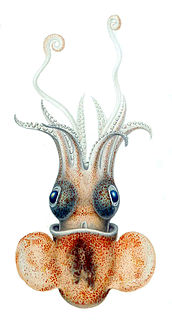 W
WAustrorossia mastigophora is a species of bobtail squid native to western, southern and eastern Africa, from Guinea and Somalia to the Cape of Good Hope. A doubtful record of this species exists from Chile. It lives at depths to approximately 640 m.
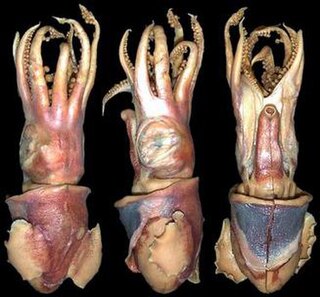 W
WChoneteuthis tongaensis is a species of bobtail squid native to the waters around the Tonga Islands in the southern Pacific Ocean. It is known from only three specimens. Of these, the holotype is the largest, at 33.8 mm mantle length (ML). C. tongaensis is characterised by several distinct morphological features: the mantle is free from the head in the nuchal region, a large, circular visceral photophore and ventral shield are present on the ventral surface of the ink sac, and the broad keel extends the full length of the club.
 W
WEuprymna is a genus of bobtail squid comprising a number of species.
 W
WHeteroteuthidinae is a subfamily of bobtail squid encompassing five genera and around ten species.
 W
WHeteroteuthis is a genus of deep-sea bobtail squid comprising five species.
 W
WHeteroteuthis hawaiiensis is a species of bobtail squid native to the central and western Pacific Ocean. It occurs in waters off Hawaii, Bonin, the Ryukyu Islands, Indonesia, and the Great Australian Bight. H. hawaiiensis may also be present in Banc Combe in the southwestern Pacific at depths of 795 to 820 m.
 W
WIdiosepius paradoxus, also known as the northern pygmy squid, is a species of bobtail squid native to the western Pacific Ocean, including the waters off South Korea, northern Australia, as well as the Japanese islands of Honshū, Kyūshū, and southern Hokkaidō. It inhabits shallow, inshore waters.
 W
WIdiosepius pygmaeus, also known as the two-toned pygmy squid, is a species of bobtail squid native to the Indo-Pacific. It occurs in waters of the South China Sea, Japan, Philippines, Palau, Indonesia, Northern Mariana Islands, as well as northern and northeastern Australia. It inhabits shallow, inshore waters.
 W
WIridoteuthis is a genus of bobtail squid comprising two species.
 W
WIridoteuthis iris is a species of bobtail squid native to the northern central Pacific Ocean; it occurs near the Hawaiian Islands off the southeast and northwest Hancock, Colahan, and Kammu seamounts. There exists a doubtful record from the Ceram Sea. Unlike most other bobtail squid, I. iris is pelagic and lives in the open ocean.
 W
WIridoteuthis maoria is a species of bobtail squid native to the southwestern Pacific Ocean. It occurs in Cook Strait and Chatham Rise off North Island in New Zealand, and has also been recorded from the Nazca and Sala y Gomez submarine ridges in the eastern Pacific.
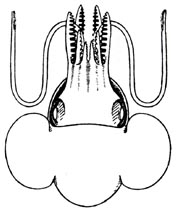 W
WNectoteuthis pourtalesi is a bathybenthic species of bobtail squid native to the tropical western Atlantic Ocean, specifically Florida and the Antilles.
 W
WNeorossia is a genus of bobtail squid comprising two species.
 W
WNeorossia leptodons is a species of bobtail squid native to the southwestern Pacific Ocean, from New South Wales to South Australia. It lives at depths from 130 to 1,110 m.
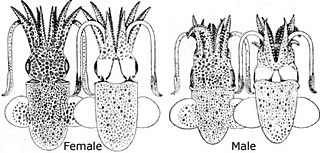 W
WRondeletiola minor, also known as the lentil bobtail, is a species of bobtail squid native to the eastern Atlantic Ocean and Mediterranean Sea. Its natural range covers the northwest of Spain, Portugal, and the eastern, central and western Mediterranean Sea to the southeastern Atlantic Benguela Current off Namibia.
 W
WRossia glaucopis is a species of bobtail squid native to the southeastern Pacific Ocean, specifically the waters around Chile.
 W
WRossiinae is a subfamily of bobtail squid encompassing four genera and around twenty species.
 W
WSemirossia is a genus of bobtail squid comprising three species.
 W
WSemirossia tenera, also known as the lesser bobtail squid, is a widespread species of bobtail squid native to the northwest Atlantic Ocean. Its natural range covers the eastern coast of North America, from the northern Gulf of Maine to the Gulf of Mexico and the Caribbean Sea. S. tenera is possibly also present in the southwest Atlantic, specifically off the coasts of Suriname, French Guiana, Brazil, and Uruguay, although the latter records are questionable.
 W
WSepietta is a genus of bobtail squid comprising three species.
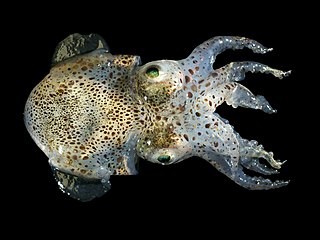 W
W W
WSepiola aurantiaca, also known as the golden bobtail squid, is a rare species of bobtail squid native to the northeastern Atlantic Ocean. It ranges from southern Norway to the western Mediterranean Sea. S. aurantiaca occurs on the outer continental shelf and in the upper bathyal zone. The depth range of this species is possibly from 200 to 400 m.
 W
WSepiola rondeletii, also known as the dwarf bobtail, is a species of bobtail squid native to the northeastern Atlantic Ocean and the Mediterranean Sea, including the Strait of Sicily, Aegean Sea, Adriatic Sea, Sea of Marmara, and Levantine Sea. In the northeastern Atlantic, its natural range extends from the North Sea to Senegal. Females grow to 60 mm in mantle length, while males are not known to exceed 25 mm ML.
 W
WSepiolidae is a family of bobtail squid encompassing 15 genera in three or four subfamilies.
 W
WSepiolina is a small genus of bobtail squid in the family Sepiolidae and the subfamily Heteroteuthidinae from the western Pacific Ocean.
 W
WSepiolina nipponensis, also known as the Japanese bobtail squid, is a bobtail squid and the only species in the genus Sepiolina. It is found in the Western Pacific in apparently widely separated populations, the most southerly of which is in the Great Australian Bight in South Australia and West Australia and then there are populations from the Philippines northwards to Taiwan, Fujian and southern Honshū.
 W
WSepiolinae is a subfamily of bobtail squid encompassing 5 genera and more than 30 species.
 W
WStoloteuthis leucoptera, also known as the butterfly bobtail squid, is a widespread species of bobtail squid. Its natural range covers the Atlantic Ocean, Mediterranean Sea, and southwestern Indian Ocean. It is distributed from the Gulf of St Lawrence to the Straits of Florida in the western Atlantic and in the Bay of Biscay in the eastern Atlantic. In the Mediterranean Sea, it is specifically found in the northern and southern Tyrrhenian Sea, Ligurian Sea, and off Gorgona Island. S. leucoptera has also been recorded from the Benguela Current off Namibia. There exist unverified records of specimens off eastern Tasmania.